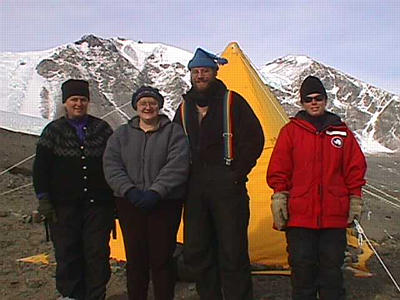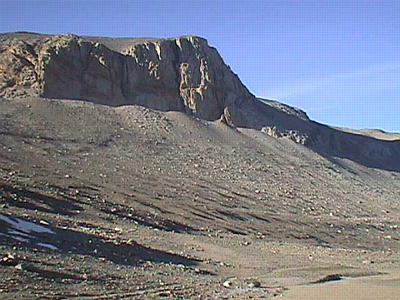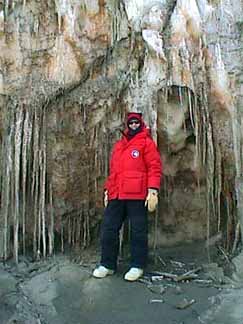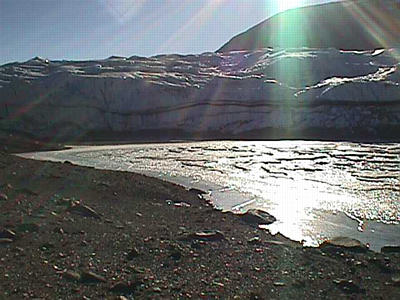5 November, 1998
I woke up nice and toasty in my tent this morning at 7:45 am. The wind
was tugging at my tent, trying to blow it away, it seemed. [But of
course, I had made sure that my strings were attached to sturdy rocks
and therefore my tent could not blow away. : )] The wind was warmer
today...the temperatures reached -4 degrees C (in the 20's F). Wow!
Since I was up a little earlier than everyone else, I attempted to make
cinnamon rolls. They turned out pretty well...they didn't rise as well
as they do at home...I think because of the lack of humidity here. (?)
As soon as everyone had had breakfast, John showed me where the sediment
traps were kept. The sediment traps were made already; I just had to
make sure that they were strung up properly, that there was a weight
attached to the bottom of it (otherwise it wouldn't sink), and that
there was a mechanism for preventing the whole trap from disappearing
down the hole. I worked on doing this for 3 sediment traps this
morning, just in case we would be able to drill more holes in the ice.
I cut bamboo lengths and crossed them for the top of the trap. This "X"
shape would prevent the trap from slipping loose at the top and
disappearing forever. This took the majority of the morning (probably
because I was practicing my knots!)
We ate lunch (soup and crackers). Mark left for McMurdo in the
helicopter. He was taking ice core samples and Nostoc samples back to
Jim Raymond in the lab. Nostoc is a cyanobacteria that lives on the
ground, in meltwater, in the ice, and in stream beds. It's actually a
black color and prefers to live in places where nitrogen is limited (you
can find it at home, too). We found a bunch of it on the ground up the
hill from camp. Jim is working on ice-active substances-- substances
that cause ice to behave in unusual ways. I don't know if I told you
about the "antifreeze" substance found in Antarctic fish down here
(really a glycoprotein), but that substance prevents ice from forming in
the fish and therefore they don't freeze to death. There are other
substances that cause ice crystals to behave in different ways. How do
you think manufacturers in the U.S. want to use these substances?
At the same time that Mark was picked up, Bjorn (a GPS support person)
was dropped off for 1-1/2 days to help Ed learn how to map the surface
of Lake Bonney. The ice surface is very rough and ridged on Lake
Bonney, and from what I understand, that changes every year. Ed wants
to document this change and maybe answer some questions about what
causes it and how it affects the microbial life in the ice.
The LTER (Long-Term Ecological Research) team arrived by helicopter
next. There are four people on this parcticular team-- Craig Wolf,
Michele Secrest, Laura Spinney, and Kathy Welch-- and they travel to the
various lakes and spend time sampling on each one. LTER has 17 sites in
the world (in deserts, tropical regions, polar regions, etc.). They
collect data in 5 main areas (primary productivity, carbon/nitrogen
levels, weather patterns, species diversity, and community composition)
and share that information with other scientists. Since there are teams
from all parts of the world, we can compare the various areas and get a
"bigger picture" of what is going on. Pretty cool, huh?
While the LTER team was unpacking and setting up their tents (they'll be
here at camp for about 5 days), I went with John to the West Lobe of
Lake Bonney to switch the data canister in the data logger (I discussed
this yesterday in my journal). We took the ATV (all-terrain vehicle)
which was quite the experience because we were driving on ice most of
the time...no sharp turns!
The West Lobe of Bonney was very different from the East Lobe...very
beautiful again but even more rocky. The terrain looked more like Mars,
with the exception of the huge and very blue glaciers spilling over the
sides of the mountains. On our way to the other lobe, we went past this
huge, perfectly smooth hill with very fine sediment covering it. There
were little sand avalanches cascading down the hill...it was mesmerizing
to watch the differently colored sand grains mix with each other as they
slowly made their way down the hill. It was like a slow-motion video!
We went through Santa Fe Creek which Scott's Expedition went through.
They made measurements of the stream bed width (which makes for good
comparison because their measurements were wider than ours). What does
that mean?
We were able to go right up to the foot of the Taylor Glacier. You
could see the sediment lines in the glacier where sediment had been
deposited as the glacier moved down the valley. Parts of the glacier
ice are a very surreal clear blue color; they look so pure and
untouchable.
We went by a stream gauge set in the creek bed (I thought it was a small
dam with a small channel set into it). The scientists use this "flume"
to measure the conductivity and flow rate of the water once it melts and
fills the stream. (Yes, there is lots of liquid water in the Antarctic
summer!). We took pictures of Blood Falls, an area of the glacier that
looks like it's bleeding due to iron oxides in the glacier. John said
later that after bringing a clear sample of water back from the glacier
and allowing it to sit a while, it turns reddish (this is the ferrous
iron becoming ferric iron...it's just being oxidized by the air).
Therefore, the outer part of the glacier that we see has had time to
oxidize.
We traveled past several more mummified seals, one of which was fairly
new...a couple of years old...because the fur was still intact and the
joints were flexible.
John changed the data canister in the data logger and checked to make
sure it was still recording accurate data.
We went back to camp. We all ate dinner together (pizza!) at 8:30 pm
(lots of research makes for a late dinner) and sat around making plans
for the next day. I went to bed around 10:30 pm...tired, tired, tired.

The LTER (Long Term Ecological Research) team-- Kathy, Michele, Craig, and Laura

John and the ATV (all terrain vehicle) we drove to the West Lobe of Lake Bonney

You can see how it looks like what you imagine Mars to be like...very rocky but very beautiful. This is the what the West Lobe of Lake Bonney looks like.

Can you see the sand avalanches in this picture?

Me at Blood Falls-- note the reddish color in the glacier. These are iron oxides in the glacier face.

Taylor Glacier-- an absolutely huge glacier of the Taylor Valley

A fairly fresh mummified seal (a couple of years old, maybe?)

John checking the data logger. It's a box that sits on the ice, and it has temp. and light sensors fingering into the ice. It records data every 20 minutes. By changing the "cans" that store data, John can take the "can" back to camp and download all of the information that it's been collecting.
Contact the TEA in the field at
.
If you cannot connect through your browser, copy the
TEA's e-mail address in the "To:" line of
your favorite e-mail package.
|
